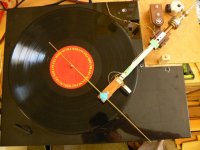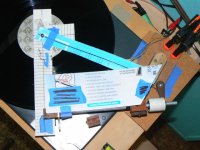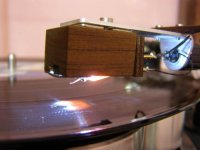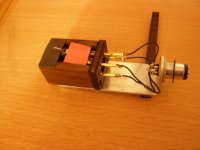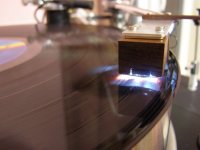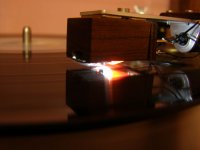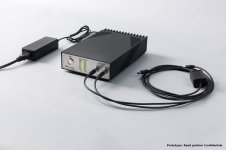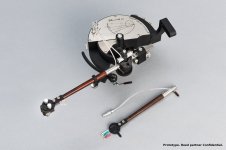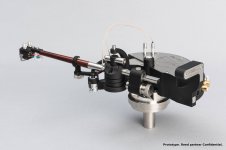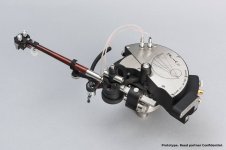Dear Andy!Hi Yuriy,
Here is the info you need. I believe Direct Driver posted pictures of the template elsewhere on this thread.
Great Britain patent GB736039.
Andy
I urge you to send a direct link to this patent!
I am in Ukraine, Google is no information about this!
For example in this topic is the picture mounting template:
http://www.diyaudio.com/forums/anal...tangential-pivot-tonearms-52.html#post3518670
But this is just a photo, and it is difficult to know the actual size of
Thank a lot!
Last edited:
runner100,
If you have not found a mounting template for your BJ arm, here are two ways that might help you find the mounting position.
1. Attach a long straight stick or rod over the stylus and perpendicular to it at the head shell and move the tonearm base until the stick always points as close as possible to the center of the spindle as you move the head shell across the record.
2. Use a strip cut from a calendar or anything else with perpendicular lines. Put one end over the spindle and move the tonearm base until the stylus is perpendicular to the long line at any point along it as you move the head shell across the record. In the photo, the important part is the strip between the spindle and head shell. You have to rotate the strip a bit for each head shell position.
I think you can get pretty close with these tricks.
If you have not found a mounting template for your BJ arm, here are two ways that might help you find the mounting position.
1. Attach a long straight stick or rod over the stylus and perpendicular to it at the head shell and move the tonearm base until the stick always points as close as possible to the center of the spindle as you move the head shell across the record.
2. Use a strip cut from a calendar or anything else with perpendicular lines. Put one end over the spindle and move the tonearm base until the stylus is perpendicular to the long line at any point along it as you move the head shell across the record. In the photo, the important part is the strip between the spindle and head shell. You have to rotate the strip a bit for each head shell position.
I think you can get pretty close with these tricks.
Attachments
Last edited:
Optical cartridge
I'm sorry for going off-topic, however if we have already discussed optical cartridge here, I would like to put my DIY project results here. I've just completed a working first prototype and tested it. It sounds encouraging . It is basically of Toshiba design, somewhat changed and optimized, with modern LED and photo-transistors on board. The same apply to proper preamp; it is based on Toshiba. With some further improvements both should go true hi-end.Tom Bloem
Here is a short description of Toshiba C100p photo cart (together with drawings).
Stereo Pickups & Phono Cartridges : 1958 - today – Stereotonabnehmer
Manual may be downloaded from vynylengine
Scheme of preamp Toshiba SZ1T in attachment here.
As to record eccentricity I would agree. Nakamichi Absolute Center Search System effectively dealt with that:
https://www.youtube.com/watch?v=SRFpd0ahvj4
Largely underestimated idea, it didn't catch up with audiophiles...
Attachments
Very interesting topic [emoji1531]...
I listened to a Thales on a top SME deck and was not actually "wowed at all"... the item that wowed me instead was the simple looking AN setup from cart to speakers...
of course there could have been many other factors , perhaps just synergy with the DV XV1T cart or something used on the Thales ... or perhaps I should have spend some actual time with it ....
anyway at the price I was expecting a lot more...
So, if the Thales etc is perfect at tracking for example , what is the actual benefits other then knowing it is technically more correct if the resulting sound does not really seem to make an extraordinary magical difference ?
I listened to a Thales on a top SME deck and was not actually "wowed at all"... the item that wowed me instead was the simple looking AN setup from cart to speakers...
of course there could have been many other factors , perhaps just synergy with the DV XV1T cart or something used on the Thales ... or perhaps I should have spend some actual time with it ....
anyway at the price I was expecting a lot more...
So, if the Thales etc is perfect at tracking for example , what is the actual benefits other then knowing it is technically more correct if the resulting sound does not really seem to make an extraordinary magical difference ?
I listened to a Thales on a top SME deck and was not actually "wowed at all"... of course there could have been many other factors , perhaps just synergy with the DV XV1T cart or something used on the Thales ... or perhaps I should have spend some actual time with it ....
anyway at the price I was expecting a lot more...
So, if the Thales etc is perfect at tracking for example , what is the actual benefits other then knowing it is technically more correct if the resulting sound does not really seem to make an extraordinary magical difference ?
First, this thread is not limited to the Thales tonearm. We are not here to promote anyone's brand.
Second, you already answered your own question that you do not know what other factor caused the sound in the SYSTEM, negative or positive. We do not know.
Third, how do you know "technically more correct" or less tracking error cannot be beneficial to the sound? It could have sounded worse without it!
It's a matter of expectation and since you saw a Thales and you might have zeroed in on that being the cause of the less than "wowed" sound. You are also focusing on the price which is not the topic of this thread and cheaper examples, in production or DIY (just ask member dtut), are out there that people reported positive results. Also let's not ignore the positive reports of the traditional linear parallel tracking tonearms out there.
======================
The sound of most analog systems aren't that noticeable when you play the first track of the record. They usually sound decent. It is always the last track that tracking error rears its ugly head and becomes most audibly noticeable. Sometimes the distortion is painfully intolerable to me.
Last edited:
Very interesting topic [emoji1531]...
I listened to a Thales on a top SME deck and was not actually "wowed at all"... the item that wowed me instead was the simple looking AN setup from cart to speakers...
of course there could have been many other factors , perhaps just synergy with the DV XV1T cart or something used on the Thales ... or perhaps I should have spend some actual time with it ....
anyway at the price I was expecting a lot more...
So, if the Thales etc is perfect at tracking for example , what is the actual benefits other then knowing it is technically more correct if the resulting sound does not really seem to make an extraordinary magical difference ?
That sounds like Andy's setup, I heard that through Tannoy Kingdom 15's and his old Autographs and I liked that a lot.
Much better than a Graham on a smaller SME through those same Kingdoms.
Linear arms and photoelectric cartridges
The sound of most analog systems aren't that noticeable when you play the first track of the record. They usually sound decent. It is always the last track that tracking error rears its ugly head and becomes most audibly noticeable. Sometimes the distortion is painfully intolerable to me.[/QUOTE]
Directdriver, in your opinion, is it a result of angular error, or maybe of slower linear speed on last tracks of LP? In last case, linear arm will not bring much of sound improvement.
As for starting a new topic, I haven't decided yet, if dedicate it to photoelectric carts only, or maybe to much wider theme of old promising designs in analog audio, those not manufactured on large scale.
The sound of most analog systems aren't that noticeable when you play the first track of the record. They usually sound decent. It is always the last track that tracking error rears its ugly head and becomes most audibly noticeable. Sometimes the distortion is painfully intolerable to me.[/QUOTE]
Directdriver, in your opinion, is it a result of angular error, or maybe of slower linear speed on last tracks of LP? In last case, linear arm will not bring much of sound improvement.
As for starting a new topic, I haven't decided yet, if dedicate it to photoelectric carts only, or maybe to much wider theme of old promising designs in analog audio, those not manufactured on large scale.
Last edited:
I meant to say tracking distortion or whatever audible distortion is more noticeable on the inner grooves and this topic has been discussed in other threads and posts here and elsewhere.
Here's an example of the kind of distortion that grates on my nerves, particularly at the chorus at 3:41. Maybe that's in the pressing. I don't know. That kind of distortion depresses me when you consider the expense in putting up an analog system like that.
Here's an example of the kind of distortion that grates on my nerves, particularly at the chorus at 3:41. Maybe that's in the pressing. I don't know. That kind of distortion depresses me when you consider the expense in putting up an analog system like that.
I saw someone posted these photos on Facebook. The latest arm 5T from Reed Audio.
Attachments
So ... I got lucky this XMAS .... a good audio friend gifted me a transfi arm with tomahawk wand as well...
It was a learning curve trying to set it up .... but once I had it going it was clearly very different...
So my beloved Alphason HR100s and 12" Jelco 750LB went to good homes..
I just have a few questions for those in the know ...
can one use the Feickert adjust plus on these tangential arms as well ... ? I had good success with the Jelco using the adjust +...
Also , and please correct me if perhaps I 'm wrong here... I suspect that this arm gives do much more detail that find if my older records are really sounding more like they look [emoji85]... and I have a lot of those....
the thing I noticed is that I was enjoying the ZYX R100 so much( perhaps cause it's big do analytical....) that I struggled to choose between it and my DV XX2 MK 2... and I suspect cause the DV was giving a bit too much details ( which included the age imperfections on a lot of my favourite LP's)..... anyway I have not finished setting up the DV to my liking as yet.... hence the adjust + question ... but already this is a winner over the other arms I had...( even Graham phantom B44 did not survive the Alphason ...)...
It was a learning curve trying to set it up .... but once I had it going it was clearly very different...
So my beloved Alphason HR100s and 12" Jelco 750LB went to good homes..
I just have a few questions for those in the know ...
can one use the Feickert adjust plus on these tangential arms as well ... ? I had good success with the Jelco using the adjust +...
Also , and please correct me if perhaps I 'm wrong here... I suspect that this arm gives do much more detail that find if my older records are really sounding more like they look [emoji85]... and I have a lot of those....
the thing I noticed is that I was enjoying the ZYX R100 so much( perhaps cause it's big do analytical....) that I struggled to choose between it and my DV XX2 MK 2... and I suspect cause the DV was giving a bit too much details ( which included the age imperfections on a lot of my favourite LP's)..... anyway I have not finished setting up the DV to my liking as yet.... hence the adjust + question ... but already this is a winner over the other arms I had...( even Graham phantom B44 did not survive the Alphason ...)...
Last edited:
Birch rebirth
Thanks Jim for alerting me to this creation!
It appears to me this is a motorized servo version of the Birch geometry. The original Birch was a passive tonearm, similar to the Schroeder LT but the Reed 5T is active using the laser above the pivot arm pointing back to the sensor and locus of the Thales geometry. Instead of the assembly travelling the record playing surface in a straight line of 4", the motorized part rotates only couple inches. Very clever. As the arm travels closer to the spindle the motorized part rotates towards the spindle as well which is virtually extending the length of the arm from the locus to the stylus tip.
A forum member, Esperado, from before had designed something like this decades ago but the sensor was placed at the spindle area. While this thread is mostly about the passive genre, I am glad someone is taking on a non-parallel tracking approach!
Ergonomically, it appears to be easy to use too, as the pivot arm is detachable for easy cartridge swap. I would prefer the base to be more compact so it's more compatible with turntables with smaller footprint. But for servo tonearm, I would happily take this over the over-engineered Derenville tonearm.
This type of project was suggested theoretically by me and others by making a motorized armpod or island for traditional pivot tonearms. Here, the Reed design team materialized it. Bravo!
Some more pictures from another site.
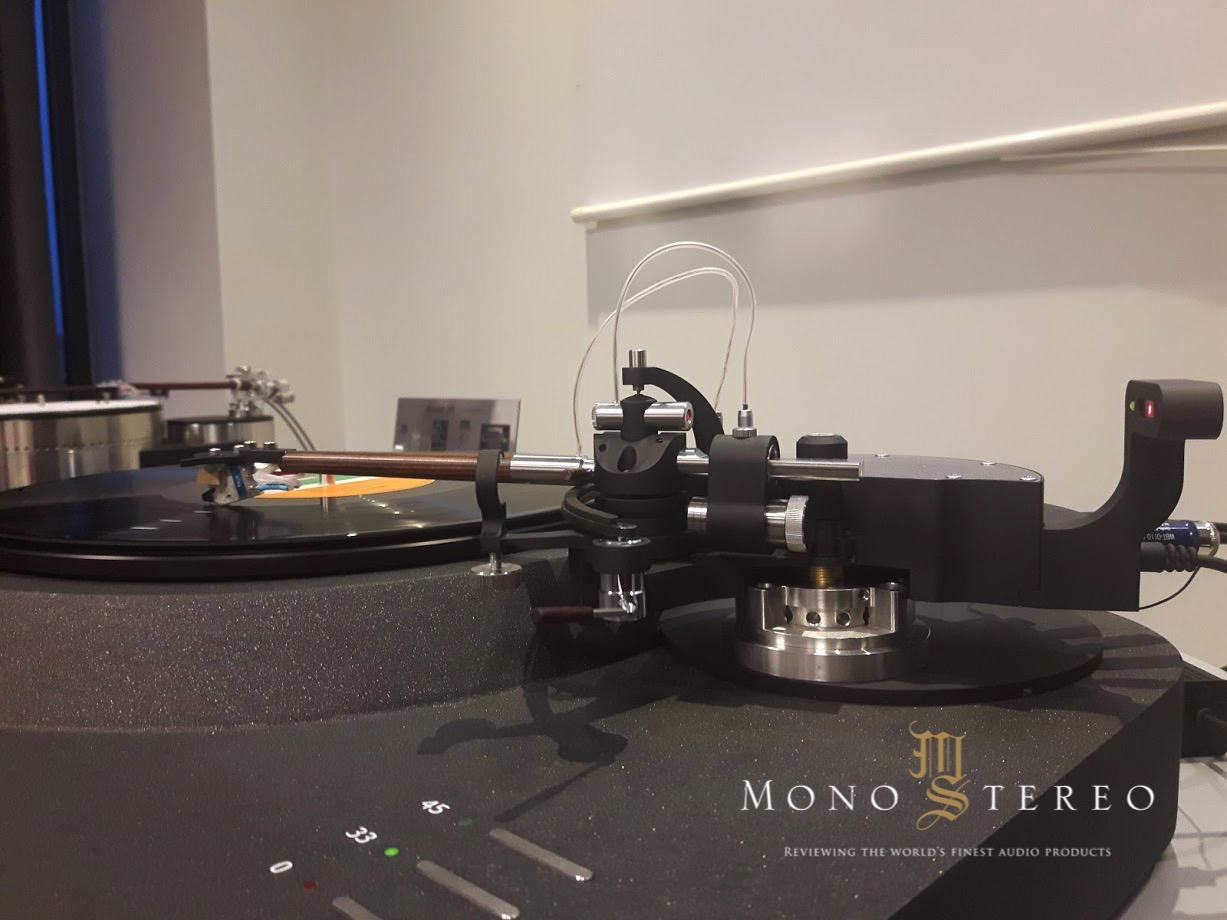
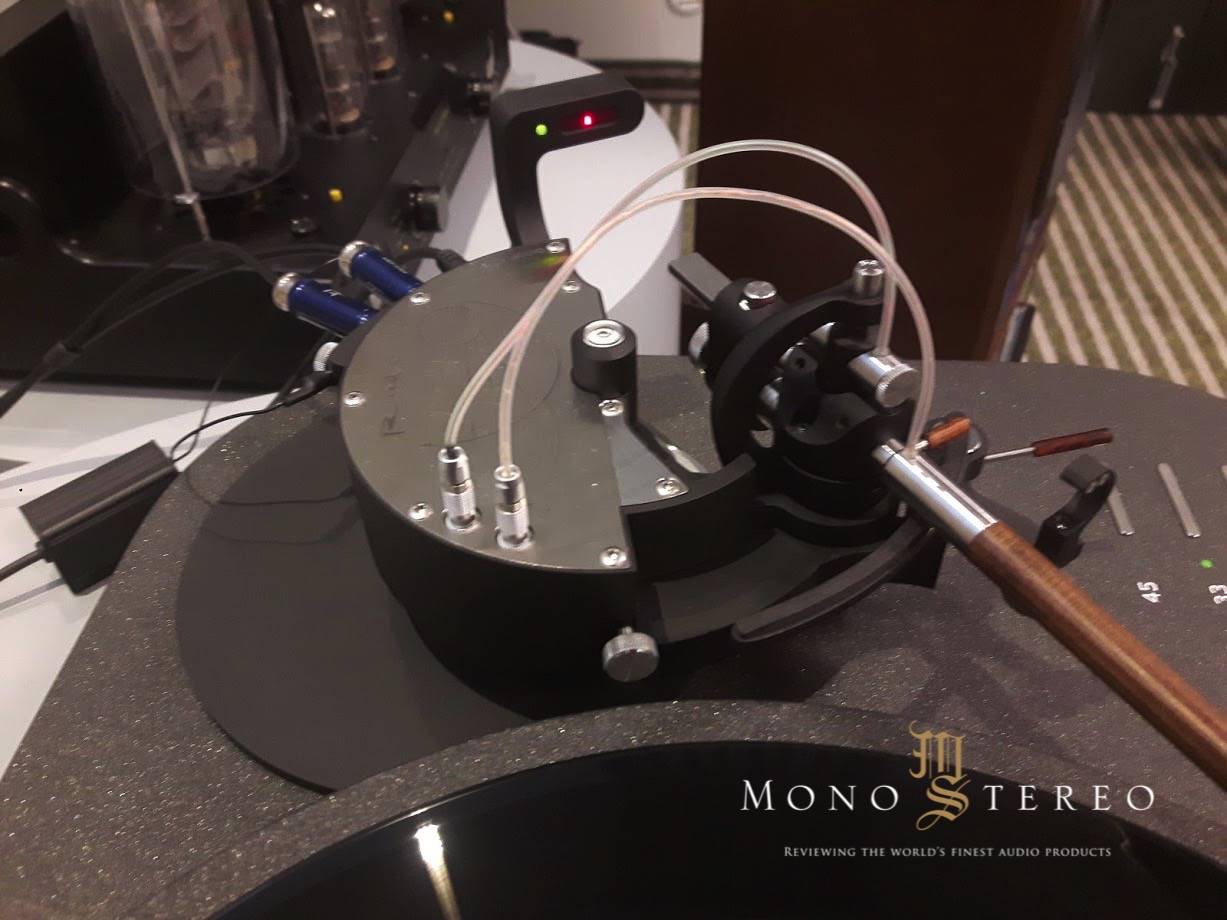
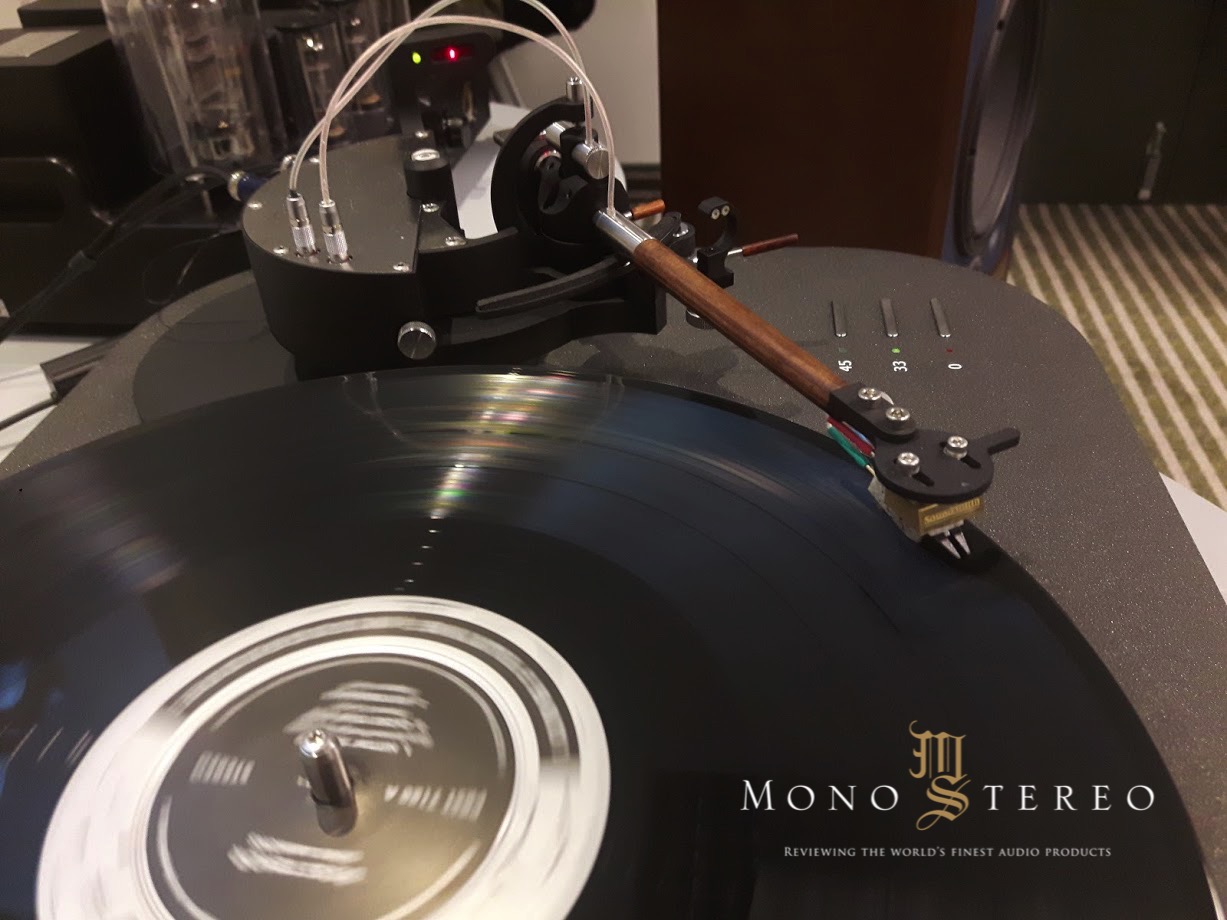
Reed geometry
Birch geometry
I saw someone posted these photos on Facebook. The latest arm 5T from Reed Audio.
Thanks Jim for alerting me to this creation!
It appears to me this is a motorized servo version of the Birch geometry. The original Birch was a passive tonearm, similar to the Schroeder LT but the Reed 5T is active using the laser above the pivot arm pointing back to the sensor and locus of the Thales geometry. Instead of the assembly travelling the record playing surface in a straight line of 4", the motorized part rotates only couple inches. Very clever. As the arm travels closer to the spindle the motorized part rotates towards the spindle as well which is virtually extending the length of the arm from the locus to the stylus tip.
A forum member, Esperado, from before had designed something like this decades ago but the sensor was placed at the spindle area. While this thread is mostly about the passive genre, I am glad someone is taking on a non-parallel tracking approach!
Ergonomically, it appears to be easy to use too, as the pivot arm is detachable for easy cartridge swap. I would prefer the base to be more compact so it's more compatible with turntables with smaller footprint. But for servo tonearm, I would happily take this over the over-engineered Derenville tonearm.
This type of project was suggested theoretically by me and others by making a motorized armpod or island for traditional pivot tonearms. Here, the Reed design team materialized it. Bravo!
Some more pictures from another site.



Reed geometry
An externally hosted image should be here but it was not working when we last tested it.
Birch geometry
An externally hosted image should be here but it was not working when we last tested it.
It seems to me that it is not very difficult to implement an active Birch geometry tangential pivot arm. 1. To use a small stepper motor at point P. 2. To use a motor speed controller or use an Arduino controller. 3. To add a stop sensor. 4. To build a pivot arm and place it on the moving circular plate. 5. To use a strong magnet at point B to guide the arm wand.
Last edited:
It seems to me that it is not very difficult to implement an active Birch geometry tangential pivot arm. 1. To use a small stepper motor at point P. 2. To use a motor speed controller or use an Arduino controller. 3. To add a stop sensor. 4. To build a pivot arm and place it on the moving circular plate. 5. To use a strong magnet at point B to guide the arm wand.
All valid points, except #5 because the sensor is already at point B, there's no need for further guiding mechanism or magnet. Member Dough Tuthill (aka "dtut") did use magnet in post #765 for his DIY arm because it was a passive arm. He also used heimjoint as guiding mechanism in post #758.
I'm just curious how the Reed 5T arm deals with eccentric records. I assume it's similar to Rabco/Goldmund going only one direction to the spindle and not over correcting it. The servo arm on the Pioneer PL-L1000 can slide both directions which is not a good idea.
- Home
- Source & Line
- Analogue Source
- Angling for 90° - tangential pivot tonearms
